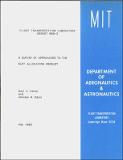A survey of approaches to the airport slot allocation problem
Author(s)
Cohen, Dayl Arlene; Odoni, Amedeo R.
DownloadFTL_R_1985_03.pdf (2.683Mb)
Other Contributors
Massachusetts Institute of Technology. Flight Transportation Laboratory
Metadata
Show full item recordAbstract
Introduction: The allocation of slots at congested major commercial airports is one of the most difficult problems facing the aviation community today. The stakes involved are very large and the controversy generated by the various proposed approaches to the problem is heated. This report is an attempt to provide a concise summary of the various proposed approaches and to discuss briefly the advantages and disadvantages of each. Four important airports (JFK International and LaGuardia in New York City, O'Hare International in Chicago and National in Washington) are now and have been since 1969 - designated as "high density terminal area" (HDTA) airports.-- Runway access to these airports is allocated among airline users through scheduling committees which meet twice a year. Access to these airports by commuter/air taxi operators and by general aviation aircraft is also rationed. At the same time, several other important airports now experience (or are on the verge of experiencing) habitually-high levels of congestion during the peak traffic hours of the day. The costs associated with this state of affairs are high. Although no particularly-reliable data exist, there is little doubt that the additional direct operating costs to the airlines due to airport congestion run in the hundreds of millions of dollars a year (and, possibly, may even exceed the one-billion-dollar mark). Indirect costs (loss of passenger time, disruption of airline schedules, missed appointments or missed flight connections, anguish and aggravation, etc.) may be just as large or larger. A successful slot-allocation system would accomplish two things simultaneously: it would "alleviate" the congestion problems just referred to until that time, if'ever, when increased airport capacity becomes available, and it would provide access to the congested airports to those aircraft 2 operators whose use of the facility offers the highest "social benefits". Unfortunately, underlying such lofty statements there are two difficult questions to be addressed, namely, "what is the optimum level of delay/congestion?" and "how does one identify the flights that offer the highest social benefits?" While the presence of a market economy provides considerable assistance in answering these questions at the theoretical level, implementation of a successful slot-allocation system is made difficult by a number of complicating factors, as will be seen later in this report. It is appropriate to classify approaches to the slot-allocation problem into two broad categories and several sub-categories: 1, Administrative Approaches a) Historically-based (or "current-use-based") allocation b) Allocation on the basis of optimization c) Allocation by lottery d) Scheduling committees 2, Economic Approaches a) Time-dependent user charges b) Auctions As suggested by this classification scheme, the main distinguishing feature that we could identify in comparing alternative approaches is whether or not an economic mechanism is explicitly used in the allocation process. The rest of this report is organized as follows: Section 2 summarizes the disadvantages of the "do nothing" strategy concerning slot allocation. Section 3 covers the administrative slot-allocation approaches and Section 4 the economic approaches. Section 5 presents a review of several important questions in this area which are yet unresolved. Finally, Section 6 presents a quite-thorough annotated bibliography of the existing literature.
Description
May 1985 Includes bibliographical references (leaves 46-55)
Date issued
1985Publisher
Cambridge, Mass. : Flight Transportation Laboratory, Dept. of Aeronautics & Astronautics, [1985]
Other identifiers
15927672
Series/Report no.
FTL report (Massachusetts Institute of Technology. Flight Transportation Laboratory) ; R85-3
Keywords
Airports, Scheduling, Access to airports, Management